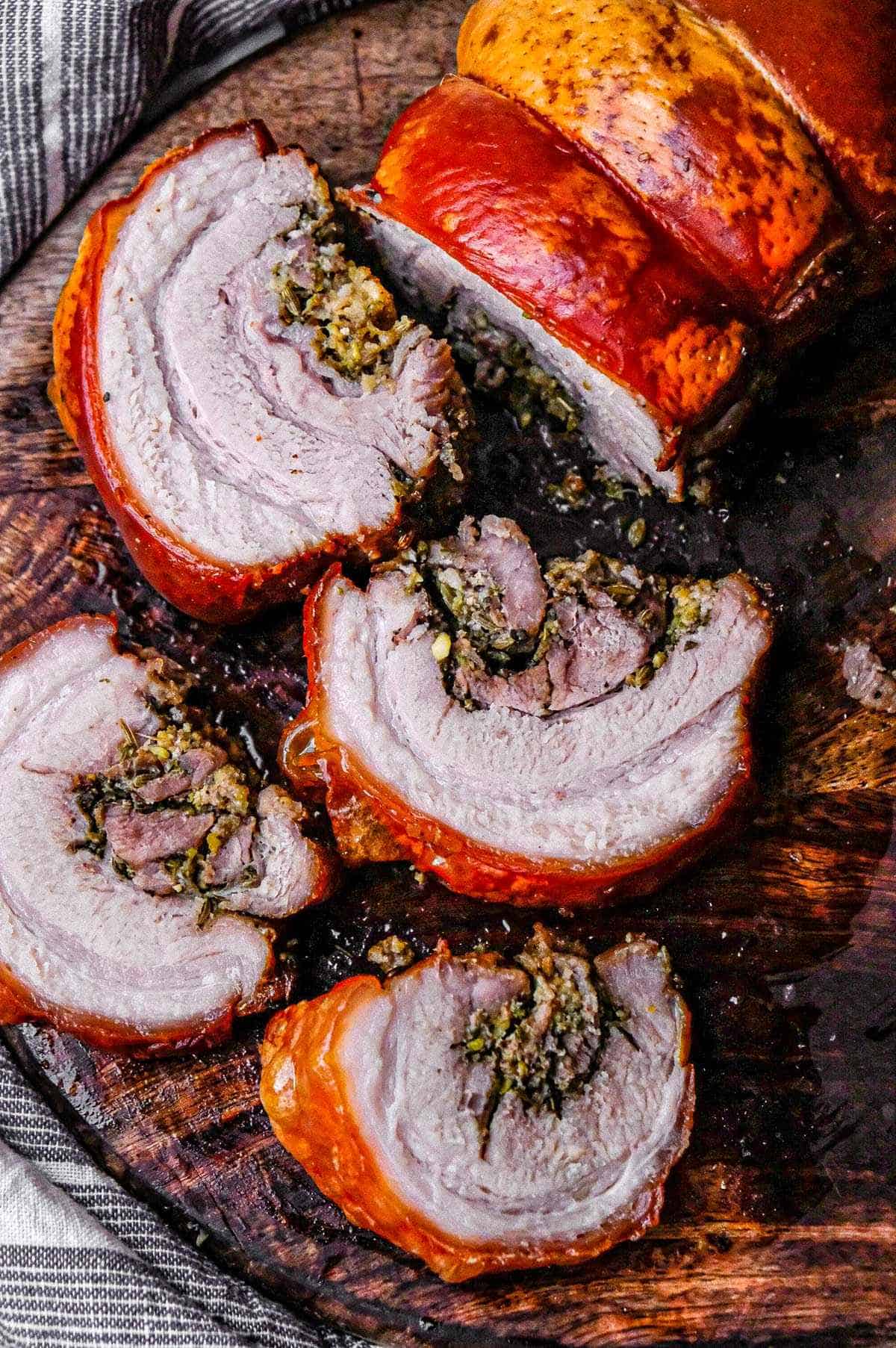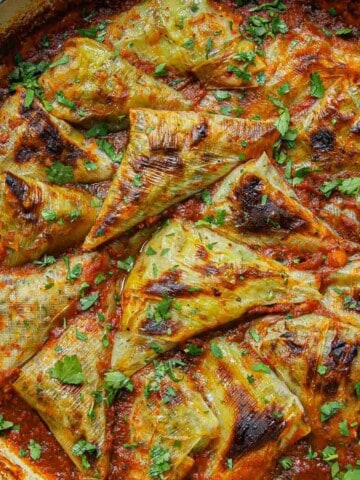Crispy pork belly porchetta stuffed with fennel seeds, ground pistachio and parmesan cheese is a flavorful, textural rollercoaster for your senses.

Crispy porchetta is a lovely meal to make if you're hosting a big group. It not only tastes amazing but it's a real showstopper. Plus, who doesn't love crispy pork skin?
Keeping the skin on the pork belly is what gives you that beautiful crispy texture. Porchetta is basically a no-fail showpiece presentation. As long as you cook it for the right amount of time and in the right way, the only seasoning that matters is the salt (and maybe a bit of garlic). Otherwise you can season to your heart's content.
The seasoning I've used here is evocative of Italian, but decidedly not a traditional take on porchetta since I didn't make reference to any specific traditional recipe but rather just combined flavors that go well together.
I love the addition of parmesan cheese, pistachio and fennel. The parmesan, fennel and pistachio bring nuttiness, umami and that sweet and mildly herbaceous quality only fennel seed can bring.
For me those three core ingredients do most of the heavy lifting, and besides salt, which is of course a prerequisite, everything else is flexible.
You can also substitute finely diced fresh basil and oregano for dry herbs which not only tastes amazing (much brighter and more complex) but also looks lovely.
Ingredients
Pork belly
Of course pork belly is the most important component. Make sure the pork belly you buy is of course one piece (a rectangular shape is best) and has the rind (i.e. the skin that covers the fat). Without the rind you won't get that beautiful crispy texture.
When choosing a piece of pork belly for porchetta you want a piece that has a roughly rectangular shape (many pieces are square). It should be wide enough to roll into a tube where the ends can come together.
For this reason, in general a bigger piece will be easier to work with than a smaller one. The difficulty with a smaller piece is that it doesn't roll as easily. This is especially the case if it's on the thicker side.
The piece of pork belly I have here is 1.5 kg, 25 cm long, 15cm wide and about 4-5 cm thick (3.3lbs, 10 inches long, 6 inches wide and about 2 inches thick). This is enough for about 8 entrée sized servings or about 12-15 sandwich servings.
Ground pistachio
The ground pistachio adds a lot of moisture and nice texture to the inside of the porchetta.
Parmesan cheese
The parmesan cheese brings moisture and a nice dose of umami savory saltiness.
Fennel seeds
Fennel seeds bring a sweet, herbaceous quality that is really incomparable to any other herb or seasoning. If you aren't familiar with fennel seeds but eat a lot of Italian food, once you taste them I think you will find the flavor instantly familiar. If you don't have fennel seeds in your spice drawer I would highly recommend you give them a try - fennel seeds can really transform dishes whether a teaspoon added to your Bolognese sauce or a generous dusting of ground seed on roast meat.
Garlic
The fresh garlic rounds out and complements the other flavors brought in from the pistachio, parmesan and fennel.
Seasoning
The rest of the seasoning is just dried herbs (oregano and basil) as well as salt, black pepper and white pepper. White pepper has a slightly milder but muskier/earthier flavor compared to black pepper.

Equipment
It really helps the porchetta crisp if you use a roasting pan with grill rack which lifts the meat out of the 'splatter zone' where the drippings will pool.
I used the Ikea Koncis stainless steel roasting pan with grill rack from Ikea which is 40cm by 32cm (12.5 by 15.5 inches).
If you really don't have a roasting pan with grill rack, no worries just use a regular roasting pan. It will be okay. After all, fat is flavor.
If you notice a lot of oil pooling in the pan at any point, you can always just use a spoon or small ladle to remove some of it.
Another very important piece of equipment is kitchen string or kitchen swine. You need this to tie the porchetta together after stuffing. Learning to truss with kitchen string takes a bit of practice.
You can see a series of very detailed photos of trussing with kitchen string in my recipe for Veal Prince Orloff: Julia Child's Classic French Recipe.
Instructions
Set up your worksurface. You'll need a large spot where you can lay the raw pork down flat (it helps if it's also easy clean up).
I like to do this directly in the roasting pan. That way any cast off seasoning is right in the pan and can meld with the pan drippings to add extra flavor (in case you feel like making a quick pan dripping gravy. Again, decidedly untraditional but oh so good.
Have all your seasonings measured out and close at hand. You will also need a good kitchen string.
There are two options for how to prepare the porchetta: prepared whole or butterflied.
Butterflying is just using a large, sharp knife to cut through the middle of the meat in order to open up the rectangular slab like a book (or some butterfly wings).
This method is especially helpful if you have a smaller, thicker piece of pork belly. It helps to thin out the piece, increase the surface area and thereby allows more even distribution of the filling.
It takes a bit of finesse to do but worth the effort if you are comfortable with a large knife.
If you do butterfly, then you can just continue the recipe as usual but distribute the filling over the now larger surface area.
The pork belly should lay on the roasting rack or worksurface with the skin side down.
Use a sharp knife to score a crosshatch pattern all across. This helps the seasoning to penetrate more deeply and also makes the pork belly easier to roll.
Unfurl a good length of the kitchen string so it's easier to start wrapping when the moment comes. About an arms length is a good start. You can also cover the rest of the string with a loose zipper bag to avoid cross-contamination.
Apply the seasoning except the ground pistachio and use your fingers to rub it in, ensuring you get into all the crevices and crosshatch cuts you made.

After the herbs are rubbed in, sprinkle on the parmesan cheese and then the pistachio.
To tie the pork belly into a roll, start by bringing together the ends that are furthest from you and knot a loop to keep them together.
Bring the piece of string towards you, loop it around the pork roll, then loop it around itself. You can see some more detailed photos of this process in my post Veal Prince Orloff: Julia Child's Classic French Recipe.

Once you've tried the whole pork belly into a roll, flip it seam side down and it's ready to roast.
How long to cook porchetta
Porchetta needs a shorter blast of heat to crisp up the skin, and then a longer roasting process to fully cook through and also allow the connective tissue collagen to begin breaking down into gelatin (which equals soft and tender pork).
The time indicated in the recipe card is for the size of pork belly I cooked. In general you should cook for 30 minutes at high heat, and then another 30 minute plus 30 minutes per each 500 grams / 1lb. So for me this was 30 minutes a high heat plus 30 and then 1.5 for the 1.5kg / 3lbs.
If your pork belly is larger just add another 30 minutes per 500 grams / 1lb.
Cook to an internal temperature of 62 C / 145 F.

Make ahead
Its also a nice idea to assemble the porchetta a day or two in advance. That way it really allows the seasoning (most importantly the salt) to penetrate and tenderize the proteins.
But if you make it same day it's also great. If you have the time, let it sit at room temperature for about 20 minutes before roasting so the seasoning can work its magic a bit.
Serving Suggestion
Porchetta is classically served in sandwich form, with some nice bread. If you eat it as a sandwich, be sure to slice it thinly with a very good knife.
If you prefer a plate to a sandwich, there are a lot of really nice carb pairings you can do. For example, the classic mashed potatoes or maybe go a bit further with creamy garlic parmesan polenta or even saffron risotto.

Related
Looking for more mealtime inspiration? Maybe you'll like one of these:
Recipe

Crispy Pork Belly Porchetta with Parmesan & Pistachio
Equipment
- roasting pan with rack
- kitchen string
Ingredients
- 1.5 kg pork belly with rind about 3 lbs
- 50 grams ground pistachio
- 50 grams parmesan cheese
- 1 tablespoon dried fennel seeds
- 5 cloves garlic mashed or minced
- 1 tablespoon olive oil
- 2 teaspoons salt
- 2 teaspoons dried oregano
- 2 teaspoons dried basil
- 0.5 teaspoon black pepper
Instructions
- Preheat oven to 225 C / 440 F.
- Unfurl about an arms length of kitchen string so it's easier to start wrapping when the moment comes.
- Flip the porchetta so it sits skin side down. Use a sharp knife to score a cross hatch pattern all across.
- Rub the pork belly all over with the salt. Sprinkle the black pepper, garlic and dried herbs onto the surface, and rub them thoroughly into the crevices.
- Sprinkle on the parmesan and ground pistachio.
- Roll up the pork belly into a tube and secure it with the kitchen string. See recipe post for details and photos.
- Place the pork belly on the rack in the roasting pan with the seam side down.
- Put in preheated oven and roast for 30 minutes, then reduce temperature to 175 C / 350 F and roast another 2 hours or until the outside is perfectly golden and hard when tapped, and the internal temperature is 62 C / 145 F.









Comments
No Comments